FET y de las JONS
Last updatedTraditionalist Spanish Phalanx of the Councils of the National Syndicalist Offensive Falange Española Tradicionalista y de las Juntas de Ofensiva Nacional Sindicalista | |
|---|---|
 | |
| Abbreviation | FET y de las JONS |
| Governing body | Movimiento Nacional [1] |
| National Chief | Francisco Franco [2] |
| Founded | 19 April 1937 |
| Dissolved | 7 April 1977 |
| Merger of | Traditionalist Communion Falange Española de las JONS |
| Headquarters | Calle de Alcalá 44, Madrid [note 1] |
| Newspaper | Arriba [4] |
| Student wing | Sindicato Español Universitario |
| Youth wing | Frente de Juventudes |
| Women's wing | Sección Femenina |
| Trade union | Spanish Syndical Organization |
| Sports body | Delegación Nacional de Deportes |
| Membership | |
| Ideology | |
| Political position | Far-right [11] [12] |
| Religion | Roman Catholicism |
| European affiliation | European Social Movement [13] [14] |
| Colours | Red Black |
| Anthem | Cara al Sol [15] |
| Party flag | |
 | |
| Part of a series on |
| Falangism |
|---|
 Yoke and arrows |
| |
| Part of a series on |
| Francoism |
|---|
 Eagle of Saint John |
The Falange Española Tradicionalista y de las Juntas de Ofensiva Nacional Sindicalista (lit. 'Traditionalist Spanish Phalanx of the Councils of the National Syndicalist Offensive'; FET y de las JONS), [16] frequently shortened to just "FET", [17] was the sole legal party of the Francoist regime in Spain. It was created by General Francisco Franco in 1937 as a merger of the fascist Falange Española de las JONS (FE de las JONS) with the monarchist neo-absolutist and integralist Catholic Traditionalist Communion belonging to the Carlist movement. [18] In addition to the resemblance of names, the party formally retained most of the platform of FE de las JONS (26 out of 27 points) and a similar inner structure. [19] In force until April 1977, it was rebranded as the Movimiento Nacional in 1958. [20]
Contents
History
Early history
The FET y de las JONS began as the Spanish Falange, a Falangist party, The Council of National Syndicalist Offensives, a national syndicalist party and Traditionalist Communion, a Catholic monarchist party, three parties that were becoming relevant in Spanish right wing politics before the civil war. The Spanish Falange and the Council of National Syndicalist Offensives were relatively small, and merged into the Spanish Falange de la JONS leading up to the 1936 election. As civil war broke out, the Falange grew rapidly in membership, and the Traditionalist Communion, already a prominent force, mobilized its forces to fight the leftist government.
Spanish Civil War
With the eruption of the Civil War in July 1936, the Falange fought on the side of the Nationalist faction against the Second Spanish Republic. Expanding rapidly from several thousand to several hundred thousand, [21] the Falange's male membership was accompanied by a female auxiliary, the Sección Femenina . Led by José Antonio's sister Pilar Primo de Rivera, this latter subsidiary organization claimed more than a half million members by the end of the war and provided nursing and support services for the Nationalist forces. [22]
The command of the party rested upon Manuel Hedilla as many of the first generation leaders were dead or incarcerated by the Republicans. Among them was Primo de Rivera, who was a government prisoner. As a result, he was referred to among the leadership as el Ausente, ("the Absent One"). After being sentenced to death on 18 November 1936, José Antonio Primo de Rivera was executed on 20 November 1936 (a date since known as 20-N in Spain) in a Republican prison, giving him martyr status among the Falangists. This conviction and sentence was possible since he'd lost his parliamentary immunity after his party did not have enough votes during the last elections.
On April 19, 1937, Francisco Franco issued a Unification Decree, which forcibly merged the Falange with the Carlist Comunión Tradicionalista to form the Falange Española Tradicionalista y de las JONS (FET y de las JONS). Franco assumed the role of jefe nacional ("National Chief"), following the model of a fascist party. [23] [note 3] All other parties supporting the rebel faction were disbanded, but former members of those parties were free to join the FET as individual members. The new party's official ideology was the Falangists' 27 puntos—reduced after the unification to 26, the article barring mergers being dropped. The merged party incorporated many Falangist symbols–the blue shirt, the yoked arrows, the red and black flag, and the anthem Cara al Sol among others. [25] Despite this, the party was in fact a wide-ranging nationalist coalition, closely controlled by Franco. Parts of the original Falange (including Hedilla) and many Carlists did not join the unified party. Franco had sought to control the Falange after a clash between Hedilla and his main critics within the group, the legitimistas of Agustín Aznar and Sancho Dávila y Fernández de Celis, that threatened to derail the Nationalist war effort. [26] Franco became jefe nacional and "Supreme Caudillo" of the FET. He was vested with "the most absolute authority," including the power to name his successor, and was only responsible to "God and history." [27]
None of the vanquished parties in the war suffered such a toll of deaths among their leaders as did the Falange. 60% of the pre-war Falange membership lost their lives in the war.
However, most of the property of all other parties and trade unions were assigned to the party. In 1938, all trade unions were unified under Falangist command.
Francoist Spain

After the war, the party was charged with developing an ideology for Franco's regime. This job became a cursus honorum for ambitious politicians—new converts, who were called camisas nuevas ("new shirts") in opposition to the more overtly populist and ideological "old shirts" from before the war.
Membership in the Falange/FET reached a peak of 932,000 in 1942. [5] Despite the official unification of the various Nationalist factions within the party in 1937, tensions continued between dedicated Falangists and other groups, particularly Carlists. Such tensions erupted in violence with the Begoña Incident of August 1942, when hardline Falangist activists attacked a Carlist religious gathering in Bilbao with grenades. The attack and the response of government ministers with Carlist leanings (most notably Varela and Galarza) led to a government crisis and caused Franco to dismiss several ministers. Ultimately, six Falangists were convicted of the attack and one, Juan Domínguez, was executed. [28]
By the middle of the Second World War, Franco and leading Falangists, while distancing themselves from the faltering European fascists, stressed the unique "Spanish Catholic authoritarianism" of the regime and the Falange. Instructions were issued in September 1943 that henceforth the Falange/FET would be referred to exclusively as a "movement" and not a "party". [29]
The Falange also developed youth organizations, with members known as Flechas and Pelayos,[ citation needed ] under the umbrella of the Spanish Youths Organization. Most of these young members wore red berets.
With improving relations with the United States, economic development and the rise of a group of relatively young technocrats within the government, the Falange continued to decline. In 1965, the SEU, the movement's student organization, was officially disbanded. [30] At the same time, the membership of the Falange as a whole was both shrinking and aging. In 1974, the average age of Falangists in Madrid was at least 55 years. The organization's relatively few new members came mostly from the conservative and devoutly Catholic areas of northern Spain. [31]
See also
Related Research Articles

The Falange Española de las Juntas de Ofensiva Nacional Sindicalista was a fascist political party founded in Spain in 1934 as merger of the Falange Española and the Juntas de Ofensiva Nacional-Sindicalista. FE de las JONS, which became the main fascist group during the Second Spanish Republic, ceased to exist as such when, during the Civil War, General Francisco Franco merged it with the Traditionalist Communion in April 1937 to form the similarly named Falange Española Tradicionalista y de las JONS.

Francoist Spain, also known as the Francoist dictatorship, was the period of Spanish history between 1936 and 1975, when Francisco Franco ruled Spain after the Spanish Civil War with the title Caudillo. After his death in 1975, Spain transitioned into a democracy. During this time period, Spain was officially known as the Spanish State.
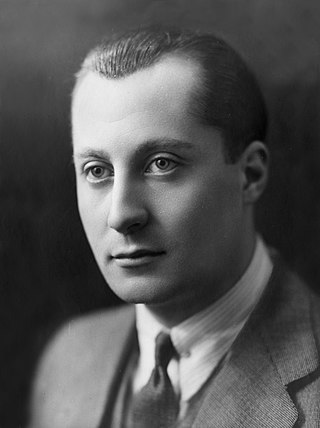
José Antonio Primo de Rivera y Sáenz de Heredia, 1st Duke of Primo de Rivera, 3rd Marquess of Estella GE, often referred to simply as José Antonio, was a Spanish fascist politician who founded the Falange Española, later Falange Española de las JONS.

The Movimiento Nacional was a governing institution of Spain established by General Francisco Franco during the Spanish Civil War in 1937. During Francoist rule in Spain, it purported to be the only channel of participation in Spanish public life. It responded to a doctrine of corporatism in which only so-called "natural entities" could express themselves: families, municipalities and unions. It was abolished in 1977.

Cara al Sol is the anthem of the Falange Española de las JONS. The lyrics were written in December 1935 and are usually credited to the leader of the Falange, José Antonio Primo de Rivera. The music was composed by Juan Tellería and Juan R. Buendia.

Falangism was the political ideology of two political parties in Spain that were known as the Falange, namely first the Falange Española de las Juntas de Ofensiva Nacional Sindicalista and afterwards the Falange Española Tradicionalista y de las Juntas de Ofensiva Nacional Sindicalista. Falangism has a disputed relationship with fascism as some historians consider the Falange to be a fascist movement based on its fascist leanings during the early years, while others focus on its transformation into an authoritarian conservative political movement in Francoist Spain.

Juntas de Ofensiva Nacional-Sindicalista was a nationalist and fascist movement in 1930s Spain. In 1934, it merged with the Falange Española into the Falange Española de las JONS.

Acción Española or AE was a Spanish cultural association active during the Second Spanish Republic, meeting point of the ultraconservative and far right intellectual figures that endorsed the restoration of the Monarchy. It was also a political magazine of the same name. The group was heavily influenced by Action Française both in its name and its ideology. Constituted in October 1931, the cultural association was inaugurated on 5 February 1932, following the founding of the journal on 15 December 1931.

The Nationalist faction or Rebel faction was a major faction in the Spanish Civil War of 1936 to 1939. It was composed of a variety of right-leaning political groups that supported the Spanish Coup of July 1936 against the Second Spanish Republic and Republican faction and sought to depose Manuel Azaña, including the Falange, the CEDA, and two rival monarchist claimants: the Alfonsist Renovación Española and the Carlist Traditionalist Communion. In 1937, all the groups were merged into the FET y de las JONS. After the death of the faction's early leaders, General Francisco Franco, one of the members of the 1936 coup, headed the Nationalists throughout most of the war, and emerged as the dictator of Spain until his death in 1975.

The National Council of the Movement, was an institution of the Franco dictatorship of a collegiate nature, which was subordinated to the Head of State. Originally created under the name of the National Council of FET and the JONS on 19 October 1937 in the midst of the Civil War, it would continue to exist until 1977, following the death of Francisco Franco and the dismantling of institutions of his regime.
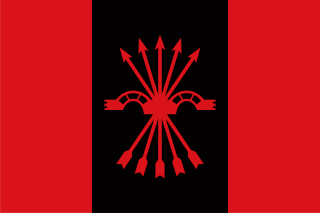
Falange Española de las JONS is a Spanish political party registered in 1976, originating from a faction of the previous Falange Española Tradicionalista y de las Juntas de Ofensiva Nacional Sindicalista. The word Falange is Spanish for phalanx. Members of the party are called Falangists. The main ideological bases of the party are national syndicalism, Third Position and ultranationalism.

José Solís Ruiz was a Spanish politician, known for his role in Francoist Spain, during which he occupied a number of important posts.
Arriba España was a Spanish newspaper published in Pamplona during the Spanish Civil War and in Francoist Spain, within the Prensa del Movimiento. The name of the publication came from the cry ¡Arriba España!, a motto that was associated with the Falangist ideology. In its early days, it coined the motto Por Dios y el César.
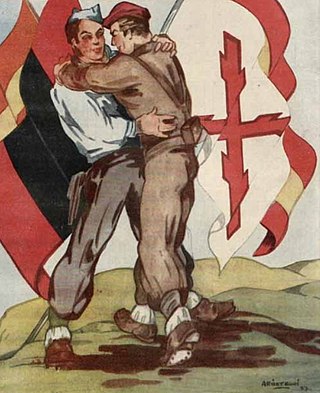
The Unification Decree was a political measure adopted by Francisco Franco in his capacity of Head of State of Nationalist Spain on April 19, 1937. The decree merged two existing political groupings, the Falangists and the Carlists, into a new party - the Falange Española Tradicionalista y de las Juntas de Ofensiva Nacional Sindicalista. As all other parties were declared dissolved at the same time, the FET became the only legal party in Nationalist Spain. It was defined in the decree as a link between state and society and was intended to form the basis for an eventual totalitarian regime. The head of state – Franco himself – was proclaimed party leader, to be assisted by the Junta Política and Consejo Nacional. A set of decrees which followed shortly after appointed members to the new executive.
The Frente de Estudiantes Sindicalistas (FES) was a Spanish student group belonging to the Falangist minority opposition to the Francoist regime.
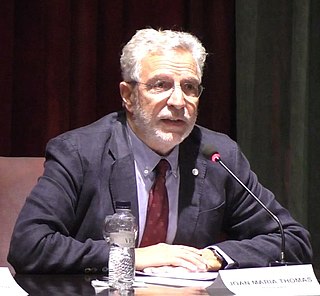
Joan Maria Thomàs Andreu is a Spanish historian. He is professor of Contemporary History at the Rovira i Virgili University and corresponding member of the Royal Academy of History. His academic production has focused on the history of falangism and the international relations of Spain during the Francoist dictatorship.
The Movimiento Español Sindicalista (MES) was a Spanish far-right political movement and predecessor of the Falange Española.
The history of the far-right in Spain dates back to at least the 1800s and refers to any manifestation of far-right politics in Spain. Individuals and organizations associated with the far-right in Spain often employ reactionary traditionalism, religious fundamentalism, corporate Catholicism, and fascism in their ideological practice. In the case of Spain, according to historian Pedro Carlos González Cuevas, the predominance of Catholicism played an essential role in the suppression of external political innovations such as Social Darwinism, positivism, and vitalism in Spanish far-right politics.
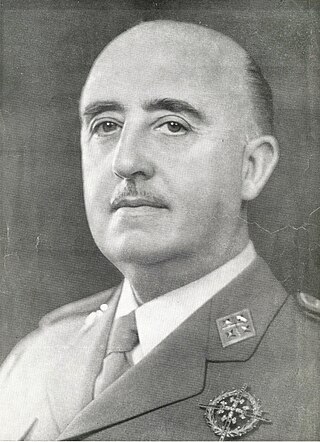
Carlo-francoism was a branch of Carlism which actively engaged in the regime of Francisco Franco. Though mainstream Carlism retained an independent stand, many Carlist militants on their own assumed various roles in the Francoist system, e.g. as members of the FET y de las JONS executive, Cortes procuradores, or civil governors. The Traditionalist political faction of the Francoist regime issued from Carlism particularly held tight control over the Ministry of Justice. They have never formed an organized structure, their dynastical allegiances remained heterogeneous and their specific political objectives might have differed. Within the Francoist power strata, the carlo-francoists remained a minority faction that controlled some 5% of key posts; they failed to shape the regime and at best served as counter-balance to other groupings competing for power.

The Servicio Exterior de Falange, sometimes known simply as the "Falange Exterior", was an organism of the Falange España Tradicionalista y de las JONS, the single party of the Franco regime. It was in charge of coordinating the actions of the various Falange delegations that existed outside Spanish territory.
References
Informational notes
- ↑ Headquarters of the General Secretariat. [3]
- ↑
- Blinkhorn 2003, pp. 10–11: "the Franco regime-the only European regime with a major radical fascist ingredient to survive long beyond 1945, and studied here by Paul Preston—is a useful example. Notwithstanding the aforementioned fascisant tendencies within the Spanish Catholic and monarchist right, radical fascism, in the form of the Falange (fused from 1934 with the JONS), was weak until 1936 when it began to expand rapidly, not least through the recruitment of disillusioned JAP-ists. [...] The product, like the Italian Fascist regime, was a compromise between radical fascism and conservative authoritarianism, in this case with unambiguous military and Church support. As Preston indicates, Falangism played a superficially prominent and important role for as long as it suited Franco, that is, until the mid-1940s, thereafter to be shunned into the sidings of Spanish political life.";
- Griffin & Feldman 2004, pp. 82–83; Albanese & Hierro 2016, p. 54: "It was the FET-JONS, the main actor in Spain, which wanted the full fascistization of the country and which was most active during the period in trying to achieve it through the so-called 'syndicalist revolution'. This should not come as a surprise; Falange did not need the fascistization process, since it was already fully fascist from the beginning. Further, relations between Falange and Italy had become increasingly stronger since the Spanish Civil War, to the extent that Mussolini saw the Spanish party at the main vehicle capable of transforming Spain into a fully fascist country. Similarly, FET-jons also regarded Mussolini's Italy as its main point of reference and even asked the authorities in Rome for advice about carrying out the fascistization process of the Francoist regime as effectively as possible.";
- Thomàs 2020, pp. 38–39: "Al referirnos a fascismo español lo hacemos a dos organizaciones diferentes. En primer lugar al partido fascista Falange Española de las JONS, que existió entre 1934 y el 19 de abril de 1937; y en segundo, al partido único del régimen franquista, Falange Española Tradicionalista y de las JONS, creado el último día citado y subsistente durante toda la vigencia del Franquismo -ni más ni menos que hasta abril de 1977, aunque en 1958 trocó su denominación por la de Movimiento Nacional. Existieron así dos organizaciones fascistas diferentes, aunque la segunda nació en parte de la primera y la integró."
- ↑ According to Enrique Moradiellos, Franco's rule as jefe nacional could be split into three periods: the first one, parallel to the period with the greatest level of fascistization of the regime, marked by the preeminence of Ramón Serrano Suñer as right hand (1937–1941); the second one, in which Franco assumed a more active role (1941–1945) in the party affairs, with the first spell of José Luis de Arrese as Secretary-General, and from 1945 until his death, the period in which Franco distanced from the daily affairs of an increasingly bureaucratic FET y de las JONS. [24]
Citations
- ↑ Payne, Stanley G. (2011-09-27). The Franco Regime, 1936–1975. University of Wisconsin Pres. p. 446. ISBN 9780299110734.
- ↑ (1937–1975)
- ↑ "El yugo y las flechas de Alcalá 44, desmontados". El País . 10 April 1977.
- ↑ Jacob Fox Watkins (2014). "Not Just "Franco 's Spain" - The Spanish Political Landscape During Re-Emergence through the Pact of Madrid". Bulletin for Spanish and Portuguese Historical Studies. 39 (1). Archived from the original on 3 February 2018. Retrieved 6 May 2015.
- 1 2 Payne 1987, p. 238.
- ↑ Cyprian P. Blamires (editor). World Fascism: A Historical Encyclopedia. Santa Barbara, California, USA: ABC-CLIO, 2006. pp. 219-220.
- ↑ "The Extreme Right in Spain - Surviving in the Shadow of Franco" (PDF). core.ac.uk. Hedda Samdahl Weltz. 2014.
- ↑ see e.g. González Cuevas 2008, pp. 1170–1171, Rodríguez Núñez 2013, Heleno Saña, Historia de la filosófia española, Madrid 2007, ISBN 9788496710986, p. 255 and onwards, in popular discourse Pradera is "one of the icons and pilars of Francoism", see ABC 25.10.04, available here
- ↑ Gonzalo Redondo Galvez, Política, cultura y sociedad en la España de Franco, 1939–1975, vol. 1, Pamplona 1999, ISBN 8431317132; according to the author, "el authoritarismo franquista no fue de signo fascista sino tradicionalista", according to another, "el authoritarismo franquista no fue de signo fascista sino tradicionalista", see Juan María Sanchez-Prieto, Lo que fué y lo que no fué Franco, [in:] Nueva Revista de Política, Cultura y Arte 69 (2000), pp. 30–38
- ↑ García-Fernández, Mónica (February 2022). "From National Catholicism to Romantic Love: The Politics of Love and Divorce in Franco's Spain". Contemporary European History . 31 (1, Special Issue: The Contemporary European History Prize). Cambridge and New York: Cambridge University Press: 2–14. doi: 10.1017/S0960777321000515 . ISSN 1469-2171.
- ↑ Albanese, Matteo Antonio; Hierro, Pablo del (2013). "Una red transnacional. La "network" de la extrema derecha entre España e Italia después de la II Guerra Mundial, 1945-1968" (PDF). Falange, las culturas políticas del fascismo en la España de Franco (1936-1975), Vol. 2, 2013, ISBN 978-84-9911-216-9, págs. 6-24. Instituto "Fernando El Católico": 6–24. Retrieved 2022-06-13.
- ↑ Grecco, Gabriela de Lima (2016). "Falange Española: de la corte literaria de José Antonio al protagonismo del nacionalcatolicismo" (PDF). História e Cultura. 5 (Extra 3): 98–118. doi:10.18223/hiscult.v5i3.1999. ISSN 2238-6270 . Retrieved 2022-06-13.
- ↑ (from 1951)
- ↑ Tauber, Kurt P. (1959). "German Nationalists and European Union". Political Science Quarterly. 74 (4): 564–589. doi:10.2307/2146424. ISSN 0032-3195. JSTOR 2146424.
- ↑ (English: Facing the Sun)
- ↑ Thomàs 2019, p. 1.
- ↑ Kershaw, Ian (2016). To Hell and Back: Europe 1914–1949. New York: Penguin Books. p. 309. ISBN 978-0-14-310992-1.
- ↑ Thomàs 2020, p. 39.
- ↑ Thomàs 2020, pp. 38–39.
- ↑ Thomàs 2020, p. 38.
- ↑ Payne 1987, p. 176.
- ↑ Payne 1987, p. 187.
- ↑ Thomàs 2013, p. 170.
- ↑ Moradiellos, Enrique (2016-04-22). Las caras de Franco: una revisión histórica del caudillo y su régimen (in Spanish). Siglo XXI de España Editores. ISBN 978-84-323-1825-2.
- ↑ Payne 1987, p. 171-172.
- ↑ Paul Preston, Franco, London: 1995, pp. 261-6
- ↑ Payne 1987, p. 175.
- ↑ Payne 1987, p. 308-09.
- ↑ Payne 1987, p. 322.
- ↑ Payne 1987, p. 523.
- ↑ Payne 1987, p. 527.
Bibliography
- Albanese, Matteo; Hierro, Pablo del (2016). Transnational Fascism in the Twentieth Century: Spain, Italy and the Global Neo-Fascist Network. Bloomsbury Publishing. ISBN 978-1-4725-3200-8 . Retrieved 5 July 2020.
- Blinkhorn, Martin (2003). Fascists and Conservatives: The Radical Right and the Establishment in Twentieth-Century Europe. Routledge. ISBN 978-1-134-99712-1.
- Griffin, Roger; Feldman, Matthew (2004). Fascism: The 'fascist epoch'. Taylor & Francis. pp. 82–83. ISBN 978-0-415-29019-7 . Retrieved 5 July 2020.
- Payne, Stanley G. (1987). The Franco Regime, 1936–1975. Madison: The University of Wisconsin Press. ISBN 978-0-299-11074-1.
- Thomàs, Joan Maria (2013). "La unificación: coyuntura y proyecto de futuro". In Ruiz Carnicer, Miguel Ángel (ed.). Falange. Las culturas políticas del fascismo en la España de Franco (1936-1975) (PDF). Zaragoza: Institución Fernando el Catolico. p. 170. ISBN 978-84-9911-216-9.
- Thomàs, Joan Maria (2019). José Antonio Primo de Rivera: The Reality and Myth of a Spanish Fascist Leader. Berghahn Books. ISBN 978-1-78920-209-0.
- Thomàs, Joan Maria (2020). "La Alemania nazi y el fascismo español durante la Guerra Civil". Cuadernos de Historia de España (in Spanish). 87 (87). Buenos Aires: Universidad de Buenos Aires: 38. doi: 10.34096/che.n87.9047 . ISSN 0325-1195.